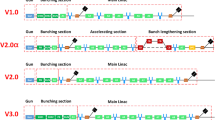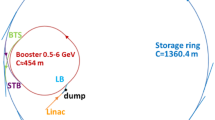Abstract
Background
The Booster Ring is further designed to store and accelerate protons up to 2 × 1012 particles per pulse in the High-Intensity heavy-ion Accelerator Facility project, which was originally designed to accelerate high-intensity heavy ion beams.
Purpose and Methods
To minimize the uncontrolled proton beam halo loss around the ring in operation, a two-stage collimation system is proposed to provide a well-shielded dump for localizing the proton beam halo loss.
Results and conclusion
In this paper, the simulation is carried out to evaluate the collimation system which shows a 92.93% collimation efficiency. Finally, several factors that affect the collimation efficiency are taken into consideration, including the physical aperture, the offset and rotation errors of the collimators, the closed orbit distortion, as well as the Betatron tunes.














Similar content being viewed by others
References
J.C. Yang, J.W. Xia, G.Q. Xiao et al., High intensity heavy ion accelerator facility (HIAF) in China. Nucl. Instrum. Methods Phys. Res. 317, 263 (2013). https://doi.org/10.1016/j.nimb.2013.08.046
H.W. Zhao, L.T. Sun, J.W. Guo et al., Superconducting ECR ion source: from 24–28 GHz SECRAL to 45 GHz fourth generation ECR. Rev. Sci. Instrum. 89, 052301 (2018). https://doi.org/10.1063/1.5017479
Z.J. Wang, Y. He, H. Jia, et al., Conceptual design of superconducting heavy ion linear injector for HIAF, in Proceedings of LINAC2012 (2012) 561–563. https://accelconf.web.cern.ch/LINAC2012/papers/tupb039.pdf
L.N. Sheng, X.H. Zhang, J.Q. Zhang et al., Ion-optical design of High energy FRagment Separator (HFRS) at HIAF. Nucl. Instrum. Methods Phys. Res. Sect. B 469, 1–9 (2020). https://doi.org/10.1016/j.nimb.2020.02.026
B. Wu, J.C. Yang, J.W. Xia et al., The design of the Spectrometer Ring at the HIAF. Nucl. Inst. Methods Phys. Res. A 881, 27–35 (2018). https://doi.org/10.1016/j.nima.2017.08.017
P. Li, Y.J. Yuan, J.C. Yang et al., The collimation system design for the Booster Ring in the HIAF project. Nucl. Instrum. Methods Phys. Res. Sect. A 920, 14–21 (2019). https://doi.org/10.1016/j.nima.2018.12.064
J.A. Hoslmes, V.V. Danilov, J.D. Galambos et al., Space charge dynamics in high intensity rings. Phys. Rev. Spec. Top. Accel. Beams 2(11), 114202 (1999). https://doi.org/10.1103/PhysRevSTAB.2.114202
A.V. Fedotov, Mechanisms of halo formation, in HALO’03 Workshop (Montauk, New York, 2003). https://doi.org/10.1063/1.1638311
A.V. Fedotov, Beam halo formation in high-intensity beams. Nucl. Instrum. Methods Phys. Res. 557, 216 (2006). https://doi.org/10.1016/j.nima.2005.10.073
A.V. Fedotov, Reasonance and beam loss in high-intensity rings, in PAC2003, pp. 383–387 (2003). https://accelconf.web.cern.ch/p03/PAPERS/WOAB002.PDF
N. Mokhov, W. Chou, et al. Beam Halo and Scraping, the report of the 7th ICFA Mini-workshop on High Intensity Brightness Hadron Beams, Lake Como, Wisconsin (1999). https://cds.cern.ch/record/476790
J.B. Jeanneret, T. Trenkler, The principles of two stage betatron and momentum collimation in circular accelerators. Part. Accel. 50, 287–311 (1995)
J.B. Jeanneret, Optics of a two-stage collimation system. Phys. Rev. ST Accel. Beams 1, 081001 (1998). https://doi.org/10.1103/PhysRevSTAB.1.081001
P.J. Bryant, E. Klein, The Design of betatron and momentum collimation systems, in CERN Accelerator School: 5th General Accelerator Physics Course, CERN 92-40, pp. 1–17 (1992). https://cds.cern.ch/record/241140/files/CM-P00062698.pdf
M. Seidel, The proton collimation system of HERA, DESY Report 1994, NO. 94–103. https://cds.cern.ch/record/265772
J. Barranco, Y. Papaphilippou, Parametric study of a two-stage beratron collimation for the PS2, in Proceedings of HB 2010, Morschach, Switzerland. https://epaper.kek.jp/HB2010/papers/tho2b02.pdf
H.A. Bethe, Molière’s theory of multiply scattering. Phys. Rev. 89, 1256 (1953). https://doi.org/10.1103/PhysRev.89.1256
K. Yamamoto, Efficiency simulation for the beam collimation system of the Japan Accelerator Research Complex rapid-cycling synchrotron. Phys. Rev. ST Accel. Beams 11, 123501 (2008). https://doi.org/10.1103/PhysRevSTAB.11.123501
R.M. Barnett et al., Review of particle properties. Phys. Rev. D 54, 1 (1996). https://doi.org/10.1103/PhysRevD.66.010001
O.B. Tarasov, D. Bazin, LISE++: Design your own spectrometer. Nucl. Phys. A 746, 411–414 (2004). https://doi.org/10.1016/j.nuclphysa.2004.09.063
J. Galambos, J. Holmes, D. Olsen, ORBIT User Manual, V.1.0, SNS-ORNL-AP Tech. Note 11, March 1999. https://web.ornl.gov/~holmesja1/JHolmes/ORBIT.html
J. Galambos, S. Danilov, D. Jeon, et al., ORBIT-a ring injection code with space charge, in The Proceedings of the 1999 Particle Accelerator Conference, New York (1999). https://doi.org/10.1109/PAC.1999.792230
H.-F. Ji, Y. Jiao, M.-Y. Huang et al., Optimization of the collimation system for CSNS/RCS with the robust conjugate direction search algorithm. Chin. Phys. C 40(9), 097006 (2016)
H. Grote, F.C. Iselin, The MAD program, Version 8.16, CERN/SL/90-13 (AP) (Rev.4) (1995). http://mad.web.cern.ch/mad/
L.P. Yao, W.P. Chai, J.C. Yang et al., Beam-loss driven injection optimization for HIAF-BRing in the presence of space charge. Nucl. Instrum. Methods Phys. Res. Sect. A 951, 162876 (2020). https://doi.org/10.1016/j.nima.2019.162876
G.F. Qu, W.P. Chai, J.W. Xia et al., Two-plane multi-turn injection scheme for BRing of HIAF. Nucl. Sci. Tech. 28, 114 (2017). https://doi.org/10.1007/s41365-017-0260-5
N. Wang, M. Y. Huang, S. Y. Xu, et al., Optimization of the collimation system for the CSNS/RCS, in Proceedings of IPAC2012, New Orleans, Louisiana, USA (2012). https://epaper.kek.jp/IPAC2012/papers/moppd075.pdf
J.A. Holmes, V. Danilov, J. Galambos, et al., Orbit: beam dynamics calculations for high-intensity rings, in The Proceedings of the EPAC 2020, Paris, France (2020). https://accelconf.web.cern.ch/e02/PAPERS/THPLE022.pdf
A.W. Chao, M. Tigner, Handbook of accelerator physics and engineering. World Scientific (1999). https://doi.org/10.1142/8543
C.R. Prior, H. SchÖnauer, Multi-turn injection into accumulators for heavy ion inertial fusion, in Proceedings of the 1996 European Particle Accelerator Conference, Sitges (1996). https://cds.cern.ch/record/311680/files/ps-96-037.pdf
M. Dorigo, L.M. Gambardella, Ant colony system: A cooperative learning approach to the traveling salesman problem. IEE Trans. Evolut. Comput. 1(1), 53–66 (1977). https://doi.org/10.1109/4235.585892
A. Colorni, M. Dorigo, V. Maniezzo. Distributed optimization by ant colonies, in Proceedings of the 1st European Conference on Artificial Life, p. 134–142 (1991). http://www-public.imtbs-tsp.eu/~gibson/Teaching/Teaching-ReadingMaterial/ColorniDorigoManiezzo91.pdf
M. Dorigo, V. Maniezzo, A. Colorni, Ant system: optimazation by a colony of cooperating agents. IEE Trans. Syst. Man Cybern. Part B 26(1), 29–41 (1996). https://doi.org/10.1109/3477.484436
B. W. Montague, Fourth-order coupling resonance excited by space charge forces in a synchrotron, CERN-Report No. 68–38, CERN (1968). https://doi.org/10.5170/CERN-1968-038
G. Wang, Closed orbit correction for the synchrotrons of HIMM and HIAF. PhD thesis, Chapter 6. University of Chinese Academy of Sciences (2020).
Acknowledgements
This work is supported by the National Natural Science Foundation of China (NSFC) (Grant No.11675235, 11975286) and the National Key R&D Program of China (Grant No.2019YFA0405401). The critical discussions with Dr H.F. Ji from CSNS are also greatly appreciated.
Author information
Authors and Affiliations
Corresponding author
Ethics declarations
Conflict of interest
The authors declare that they have no known competing financial interests or personal relationships that could have appeared to influence the work reported in this paper.
Rights and permissions
Springer Nature or its licensor holds exclusive rights to this article under a publishing agreement with the author(s) or other rightsholder(s); author self-archiving of the accepted manuscript version of this article is solely governed by the terms of such publishing agreement and applicable law.
About this article
Cite this article
Zheng, WH., Yang, JC., Li, P. et al. Design of proton beam collimation system for HIAF-BRing. Radiat Detect Technol Methods 6, 519–529 (2022). https://doi.org/10.1007/s41605-022-00351-3
Received:
Revised:
Accepted:
Published:
Issue Date:
DOI: https://doi.org/10.1007/s41605-022-00351-3




